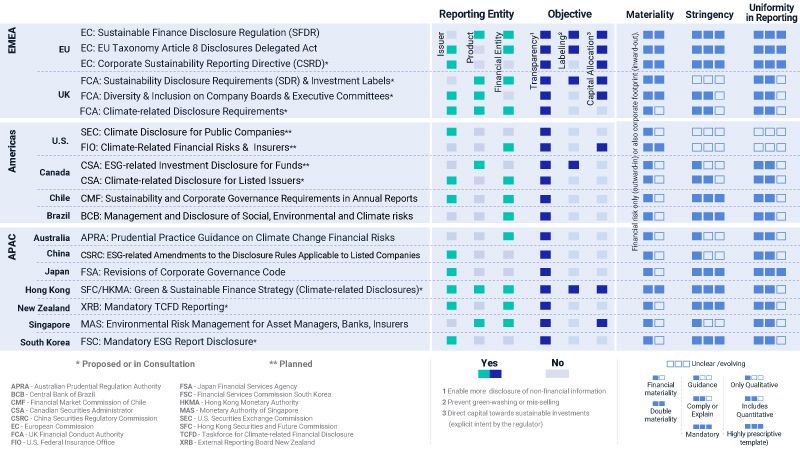Regulation at a Crossroads: Convergence or Fragmentation?
Video
December 2, 2021
With at least 34 regulatory bodies and standard setters in 12 markets undertaking official consultations on ESG in 2021 alone, it's no wonder that companies' and investors' heads are spinning. We see convergence in some core areas, yet there are signs of further fragmentation, driven by differing regional priorities. Just take a look at our preliminary analysis below that compared the current pipeline of rules and proposals from select agencies in key jurisdictions along five dimensions: reporting target; objectives; materiality; stringency and uniformity of reporting. All of these proposals tackle the issue of transparency in ESG investment standards, yet there is a lack of uniformity in the other initiatives of the regulations. Such differences could prove a persistent obstacle to global convergence on ESG-related regulations.

1 Initiatives that have been announced with limited detail as of the time of writing include: the U.S. SEC disclosure on human capital management and board diversity; the Swiss Federal Council planning mandatory climate reporting for large Swiss companies and for financial market players; the EU Sustainable Corporate Governance Directive (expected for Q4 2021); and the UK FCA Sustainability Disclosure Requirements for Companies. 2 As of the time of this writing, taxonomies existed or were in the proposal stage in many parts of the world: EU, China, Hong Kong, Malaysia, Singapore, UK, and the ASEAN region, plus the Common Ground developed between EU and China. 3 Inclusion of climate-related stress tests into prudential regulation is being promoted by the Network for Greening the Financial System (NGFS) with over 100 Central Banks. Climate stress tests for banks are currently being undertaken or planned in many jurisdictions, e.g. Canada, EU, Hong Kong, Malaysia, UK, US.
Subscribe todayto have insights delivered to your inbox.
2022 Trends to Watch
Ten trends for the coming year that could shape the risk profile for investors.
Putting ESG Ratings in Their Rightful Place
Regulation and market forces could encourage codes of conduct for constructing ESG ratings, making clear what they capture — and what they don't.
The Story Behind ESG Trends
10 Year Anniversary – What Can The Past Tell Us About The Future?
The content of this page is for informational purposes only and is intended for institutional professionals with the analytical resources and tools necessary to interpret any performance information. Nothing herein is intended to recommend any product, tool or service. For all references to laws, rules or regulations, please note that the information is provided “as is” and does not constitute legal advice or any binding interpretation. Any approach to comply with regulatory or policy initiatives should be discussed with your own legal counsel and/or the relevant competent authority, as needed.